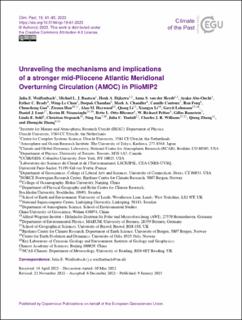| dc.contributor.author | Weiffenbach, Julia E. | |
| dc.contributor.author | Baatsen, Michiel L. J. | |
| dc.contributor.author | Dijkstra, Henk A. | |
| dc.contributor.author | Von Der Heydt, Anna S. | |
| dc.contributor.author | Abe-Ouchi, Ayako | |
| dc.contributor.author | Brady, Esther C. | |
| dc.contributor.author | Chan, Wing-Le | |
| dc.contributor.author | Chandan, Deepak | |
| dc.contributor.author | Chandler, Mark A. | |
| dc.contributor.author | Contoux, Camille | |
| dc.contributor.author | Feng, Ran | |
| dc.contributor.author | Guo, Chuncheng | |
| dc.contributor.author | Han, Zixuan | |
| dc.contributor.author | Haywood, Alan M. | |
| dc.contributor.author | Li, Qiang | |
| dc.contributor.author | Li, Xiangyu | |
| dc.contributor.author | Lohmann, Gerrit | |
| dc.contributor.author | Lunt, Daniel J. | |
| dc.contributor.author | Nisancioglu, Kerim Hestnes | |
| dc.contributor.author | Otto-Bliesner, Bette L. | |
| dc.contributor.author | Peltier, W. Richard | |
| dc.contributor.author | Ramstein, Gilles | |
| dc.contributor.author | Sohl, Linda E. | |
| dc.contributor.author | Stepanek, Christian | |
| dc.contributor.author | Tan, Ning | |
| dc.contributor.author | Tindall, Julia C. | |
| dc.contributor.author | Williams, Charles J. R. | |
| dc.contributor.author | Zhang, Qiong | |
| dc.contributor.author | Zhang, Zhongshi | |
| dc.date.accessioned | 2023-07-04T09:20:59Z | |
| dc.date.available | 2023-07-04T09:20:59Z | |
| dc.date.created | 2023-02-26T13:12:43Z | |
| dc.date.issued | 2023 | |
| dc.identifier.citation | Climate of the Past. 2023, 19 (1), 61-85. | en_US |
| dc.identifier.issn | 1814-9324 | |
| dc.identifier.uri | https://hdl.handle.net/11250/3075505 | |
| dc.description.abstract | The mid-Pliocene warm period (3.264–3.025 Ma) is the most recent geological period in which the atmospheric CO2 concentration was approximately equal to the concentration we measure today (ca. 400 ppm). Sea surface temperature (SST) proxies indicate above-average warming over the North Atlantic in the mid-Pliocene with respect to the pre-industrial period, which may be linked to an intensified Atlantic Meridional Overturning Circulation (AMOC). Earlier results from the Pliocene Model Intercomparison Project Phase 2 (PlioMIP2) show that the ensemble simulates a stronger AMOC in the mid-Pliocene than in the pre-industrial. However, no consistent relationship between the stronger mid-Pliocene AMOC and either the Atlantic northward ocean heat transport (OHT) or average North Atlantic SSTs has been found. In this study, we look further into the drivers and consequences of a stronger AMOC in mid-Pliocene compared to pre-industrial simulations in PlioMIP2. We find that all model simulations with a closed Bering Strait and Canadian Archipelago show reduced freshwater transport from the Arctic Ocean into the North Atlantic. This contributes to an increase in salinity in the subpolar North Atlantic and Labrador Sea that can be linked to the stronger AMOC in the mid-Pliocene. To investigate the dynamics behind the ensemble's variable response of the total Atlantic OHT to the stronger AMOC, we separate the Atlantic OHT into two components associated with either the overturning circulation or the wind-driven gyre circulation. While the ensemble mean of the overturning component is increased significantly in magnitude in the mid-Pliocene, it is partly compensated by a reduction in the gyre component in the northern subtropical gyre region. This indicates that the lack of relationship between the total OHT and AMOC is due to changes in OHT by the subtropical gyre. The overturning and gyre components should therefore be considered separately to gain a more complete understanding of the OHT response to a stronger mid-Pliocene AMOC. In addition, we show that the AMOC exerts a stronger influence on North Atlantic SSTs in the mid-Pliocene than in the pre-industrial, providing a possible explanation for the improved agreement of the PlioMIP2 ensemble mean SSTs with reconstructions in the North Atlantic. | en_US |
| dc.language.iso | eng | en_US |
| dc.rights | Navngivelse 4.0 Internasjonal | * |
| dc.rights.uri | http://creativecommons.org/licenses/by/4.0/deed.no | * |
| dc.title | Unraveling the mechanisms and implications of a stronger mid-Pliocene Atlantic Meridional Overturning Circulation (AMOC) in PlioMIP2 | en_US |
| dc.title.alternative | Unraveling the mechanisms and implications of a stronger mid-Pliocene Atlantic Meridional Overturning Circulation (AMOC) in PlioMIP2 | en_US |
| dc.type | Peer reviewed | en_US |
| dc.type | Journal article | en_US |
| dc.rights.holder | © Author(s) 2023 | en_US |
| dc.description.version | publishedVersion | en_US |
| cristin.ispublished | true | |
| cristin.fulltext | original | |
| cristin.qualitycode | 1 | |
| dc.identifier.doi | 10.5194/cp-19-61-2023 | |
| dc.identifier.cristin | 2129324 | |
| dc.source.journal | Climate of the Past | en_US |
| dc.source.volume | 19 | en_US |
| dc.source.issue | 1 | en_US |
| dc.source.pagenumber | 61-85 | en_US |

